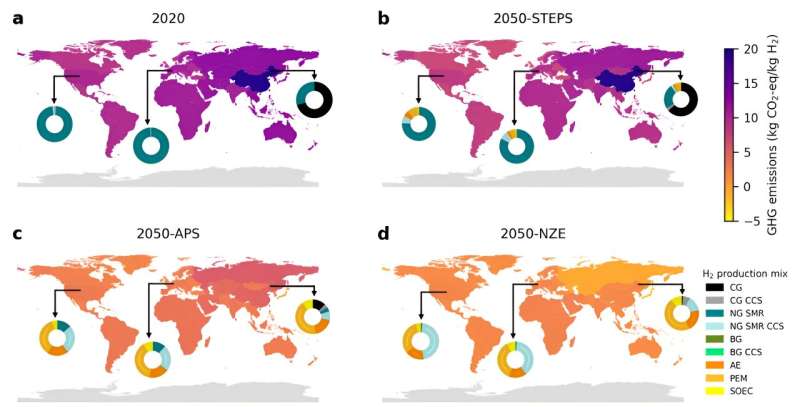This article has been reviewed according to Science X's editorial process and policies. Editors have highlighted the following attributes while ensuring the content's credibility:
fact-checked
trusted source
proofread
How the world can achieve climate goals with clean hydrogen production

Driving on hydrogen and using it to heat our homes could be a solution to the climate problem. At least, if we start producing it in the right, clean way. Leiden researchers mapped out the global environmental impact of hydrogen production and looked ahead to 2050. They published their work in Energy & Environmental Science.
With a car running on hydrogen, only water vapor comes out of the exhaust. With a relatively small adjustment, our gas pipelines can also transport hydrogen, so we could use it to heat our homes. The catch: When producing hydrogen, a lot of CO2 is usually released. On average, fourteen kilograms per kilogram of hydrogen.
Currently, natural gas is the most efficient and important raw material for hydrogen gas. In methane steam-reforming technology, steam, i.e., water, reacts with methane gas at 700°C to 1,100°C, producing synthesis gas and hydrogen. Something similar happens with coal.
Shijie Wei, a Ph.D. candidate at the Institute of Environmental Sciences, is the first author of the article "Future environmental impacts of global hydrogen production." He calculated the environmental impact of current global hydrogen production and explored possible future scenarios. He used a method called life cycle assessment (LCA), which he used to assess all environmental impacts associated with nine hydrogen production technologies.
His findings are alarming, says his supervisor Bernhard Steubing. "If hydrogen production increases by a factor of four to eight as expected, it could emit up to 12% of the remaining carbon budget we have left by 2050 to keep global warming to no more than 1.5°C."
Relying on capturing and storing CO2 is risky
To an important extent, this is due to the use of fossil fuels—e.g., natural gas—as a source of hydrogen production. The authors follow scenarios from the International Energy Agency, which projects that natural gas will be used to an important degree in steam methane reforming coupled with capturing and storing CO2.
According to Wei, this is risky. "With this technology, we are holding on to fossil fuels. Moreover, this would still lead to yearly carbon emissions of up to 1 gigaton of CO2 per year from hydrogen production by 2050."
Wei calculated these annual emissions by assuming that a total of 64% of all CO2 released in hydrogen production could be captured. "Some others assume as much as 96%, but they assume that CO2 released in the smoke gas from the burner that provides the heat for the reaction is also captured. We have only assumed capturing the CO2 released in the steam-methane gas reaction itself, which is the more economical option."
Being able to capture the CO2 from flue gas is very expensive and there are technical challenges involved. "We have to take into account that despite CO2 capture and storage, a lot of emissions remain. Year after year for as long as this storage infrastructure lasts."
Count your loss, Wei says, "Those yearly emissions will continue as long as the technical lifetime of this storage infrastructure." Even if higher capture efficiencies can be achieved, Wei thinks it is better not to go down this road and not invest into this infrastructure at all.
Water electrolysis is much cleaner if renewable electricity is used
There is a better way: the method using electricity and water, where only hydrogen and oxygen are produced. This so-called water electrolysis is much cleaner than other production pathways if renewable electricity is used. Ideally, solar and wind farms are connected to an electrolyzer. When it's windy at a time when the electricity grid can't use power, the electrolyzer converts the excess electricity into hydrogen. Such highly flexible systems already exist.
Steubing says, "If we switch to hydrogen production through electrolysis with renewable energy as quickly as possible, we can prevent a lot of CO2 emissions."
Supervisor and co-author Arnold Tukker strongly advises policymakers, "Accelerate the expansion of renewable energy generation, develop electrolysis faster. Thinking we can solve the climate problem with hydrogen by betting on steam methane reforming with carbon capture and storage is incredibly risky. Once you have build such an infrastructure, you will be locked in.
"You must use it for decades. We can't emit 1 gigaton of CO2 for so long for hydrogen production alone. You can only bring this down drastically by adding costly post-combustion carbon capture and storage, which we did not include. Electrolysis is clearly the safer bet."
More information: Shijie Wei et al, Future environmental impacts of global hydrogen production, Energy & Environmental Science (2024). DOI: 10.1039/D3EE03875K
















